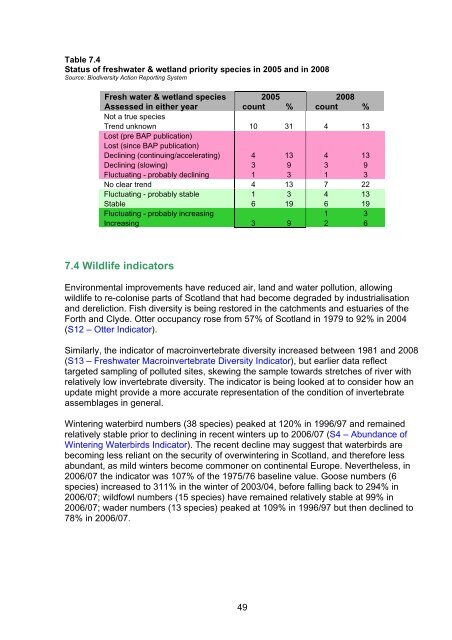Scotland's Wildlife â an assessment of biodiversity in 20
Scotland's Wildlife â an assessment of biodiversity in 20
Scotland's Wildlife â an assessment of biodiversity in 20
You also want an ePaper? Increase the reach of your titles
YUMPU automatically turns print PDFs into web optimized ePapers that Google loves.
Table 7.4<br />
Status <strong>of</strong> freshwater & wetl<strong>an</strong>d priority species <strong>in</strong> <strong>20</strong>05 <strong>an</strong>d <strong>in</strong> <strong>20</strong>08<br />
Source: Biodiversity Action Report<strong>in</strong>g System<br />
Fresh water & wetl<strong>an</strong>d species <strong>20</strong>05 <strong>20</strong>08<br />
Assessed <strong>in</strong> either year count % count %<br />
Not a true species<br />
Trend unknown 10 31 4 13<br />
Lost (pre BAP publication)<br />
Lost (s<strong>in</strong>ce BAP publication)<br />
Decl<strong>in</strong><strong>in</strong>g (cont<strong>in</strong>u<strong>in</strong>g/accelerat<strong>in</strong>g) 4 13 4 13<br />
Decl<strong>in</strong><strong>in</strong>g (slow<strong>in</strong>g) 3 9 3 9<br />
Fluctuat<strong>in</strong>g - probably decl<strong>in</strong><strong>in</strong>g 1 3 1 3<br />
No clear trend 4 13 7 22<br />
Fluctuat<strong>in</strong>g - probably stable 1 3 4 13<br />
Stable 6 19 6 19<br />
Fluctuat<strong>in</strong>g - probably <strong>in</strong>creas<strong>in</strong>g 1 3<br />
Increas<strong>in</strong>g 3 9 2 6<br />
7.4 <strong>Wildlife</strong> <strong>in</strong>dicators<br />
Environmental improvements have reduced air, l<strong>an</strong>d <strong>an</strong>d water pollution, allow<strong>in</strong>g<br />
wildlife to re-colonise parts <strong>of</strong> Scotl<strong>an</strong>d that had become degraded by <strong>in</strong>dustrialisation<br />
<strong>an</strong>d dereliction. Fish diversity is be<strong>in</strong>g restored <strong>in</strong> the catchments <strong>an</strong>d estuaries <strong>of</strong> the<br />
Forth <strong>an</strong>d Clyde. Otter occup<strong>an</strong>cy rose from 57% <strong>of</strong> Scotl<strong>an</strong>d <strong>in</strong> 1979 to 92% <strong>in</strong> <strong>20</strong>04<br />
(S12 – Otter Indicator).<br />
Similarly, the <strong>in</strong>dicator <strong>of</strong> macro<strong>in</strong>vertebrate diversity <strong>in</strong>creased between 1981 <strong>an</strong>d <strong>20</strong>08<br />
(S13 – Freshwater Macro<strong>in</strong>vertebrate Diversity Indicator), but earlier data reflect<br />
targeted sampl<strong>in</strong>g <strong>of</strong> polluted sites, skew<strong>in</strong>g the sample towards stretches <strong>of</strong> river with<br />
relatively low <strong>in</strong>vertebrate diversity. The <strong>in</strong>dicator is be<strong>in</strong>g looked at to consider how <strong>an</strong><br />
update might provide a more accurate representation <strong>of</strong> the condition <strong>of</strong> <strong>in</strong>vertebrate<br />
assemblages <strong>in</strong> general.<br />
W<strong>in</strong>ter<strong>in</strong>g waterbird numbers (38 species) peaked at 1<strong>20</strong>% <strong>in</strong> 1996/97 <strong>an</strong>d rema<strong>in</strong>ed<br />
relatively stable prior to decl<strong>in</strong><strong>in</strong>g <strong>in</strong> recent w<strong>in</strong>ters up to <strong>20</strong>06/07 (S4 – Abund<strong>an</strong>ce <strong>of</strong><br />
W<strong>in</strong>ter<strong>in</strong>g Waterbirds Indicator). The recent decl<strong>in</strong>e may suggest that waterbirds are<br />
becom<strong>in</strong>g less reli<strong>an</strong>t on the security <strong>of</strong> overw<strong>in</strong>ter<strong>in</strong>g <strong>in</strong> Scotl<strong>an</strong>d, <strong>an</strong>d therefore less<br />
abund<strong>an</strong>t, as mild w<strong>in</strong>ters become commoner on cont<strong>in</strong>ental Europe. Nevertheless, <strong>in</strong><br />
<strong>20</strong>06/07 the <strong>in</strong>dicator was 107% <strong>of</strong> the 1975/76 basel<strong>in</strong>e value. Goose numbers (6<br />
species) <strong>in</strong>creased to 311% <strong>in</strong> the w<strong>in</strong>ter <strong>of</strong> <strong>20</strong>03/04, before fall<strong>in</strong>g back to 294% <strong>in</strong><br />
<strong>20</strong>06/07; wildfowl numbers (15 species) have rema<strong>in</strong>ed relatively stable at 99% <strong>in</strong><br />
<strong>20</strong>06/07; wader numbers (13 species) peaked at 109% <strong>in</strong> 1996/97 but then decl<strong>in</strong>ed to<br />
78% <strong>in</strong> <strong>20</strong>06/07.<br />
49
















